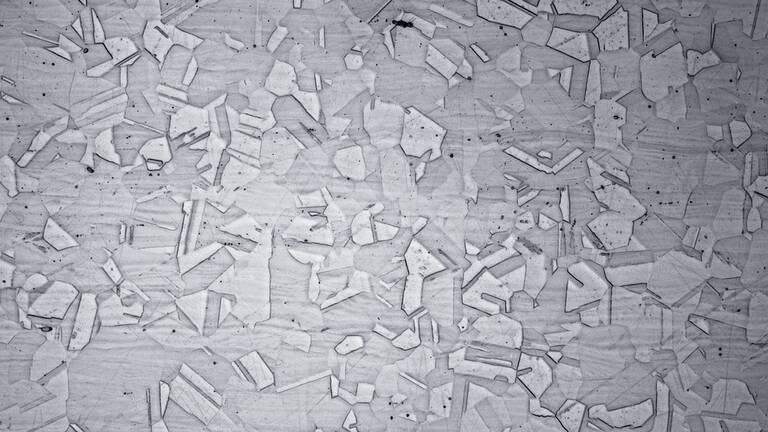Our stainless precision steel strip with an austenitic, ferritic, or martensitic microstructure stands out thanks to precisely defined material properties that are maintained within extremely tight tolerances across numerous delivery batches. This guarantees perfect reproducibility for our customers during further processing and ensures that they can fully count on the fact that their final products will have the desired properties.
Precision steel strip made of stainless steel according to DIN EN 10088, DIN ISO 9445, and DIN EN 10151
Whether corrosion resistance, acid resistance, or heat resistance – our precision steel strip made of stainless steel offers unparalleled performance. This is especially true in the case of above-average requirements for formability or later properties. Depending on the version of the stainless materials with austenitic, ferritic, or martensitic microstructures, we achieve extremely high levels of tensile strength, excellent bending uniformity, as well as outstanding formability and punchability through specially designed rolling and annealing processes that complement each other perfectly.
Our corrosion-resistant precision steel strip has been widely used for many years, particularly for demanding applications in medical technology as well as safety-related components in the automotive and electrical engineering industries. Stainless cold rolled steel strip in extremely low nominal thicknesses of 0.05 to 0.20 mm (0.002 to 0.0079 inch) is used, for example, in the production of bipolar plates for fuel cells. At the other end of the requirements scale, our advanced annealing processes also enable us to offer grades with ferritic and martensitic microstructures up to 4 mm thick, which significantly exceed general standards.
Characteristics and available batch sizes of our stainless precision steel strip
- Thickness ranges: from 0.05 – 4.00 mm (0.002 – 0.157 inch) (depending on the microstructure)
- Widths: from 3 – 650 mm (0.118 – 25.59 inch)
- Various surface finishes available: e.g., high-gloss, matte, roughened or patterned (on one side)
- Edge machining to achieve the highest load capacities for spring elements
- Minimum batch size: 2.5 metric tons (5511 lbs) (smaller quantities starting at 25 kg (55 lbs) available via our service centers)
- The stainless microstructures austenite, ferrite, and martensite are also available as profiles.
Application examples for stainless precision steel strip
- Medical technology, e.g., cannulas, insulin pens
- Safety-related components in the automotive industry, e.g.: retaining clips for brake pads, ABS system magnet sleeves
- Automotive industry, e.g.: spring washers, hose clamps, fuel injectors
- Hydrogen technology, e.g., bipolar plates
- Safety-related components in electrical engineering, e.g., connecting elements in sockets and oversprings for plug connectors and pole contacts
- Furniture industry, e.g., fittings and complex housing parts
- Tools, e.g., pruning shears, multifunctional tools
- Deep-drawn applications, e.g., battery cans (for devices/applications with a long service life such as submarines, ships, aircraft, satellites)
- Fastening elements
- Precision tubing for submarine cables
Grain size of stainless steel materials configured to exact specifications
Thanks to specially designed rolling and annealing processes that complement each other perfectly, we can customize the grain size of our stainless steel grades to meet our customers’ exact requirements, while always achieving an extremely homogeneous grain structure. In addition to the highest standards of quality, we guarantee extremely consistent material properties within tight tolerances across numerous delivery batches. This ensures optimal processing properties and exact reproducibility in our customers’ production processes, which is especially important when manufacturing complex components.
Stainless steel alloys for optimized corrosion, acid, and heat resistance
We use the main alloying elements chromium and nickel to create a material that is highly resistant to corrosion, acids, and heat, thereby eliminating the need for costly and time-consuming galvanic finishing processes. Additives such as molybdenum, niobium, or titanium can be used to further optimize corrosion, acid, and heat resistance and to give the material additional technological properties such as deep-drawing, bending, or punching properties, as well as spring properties optimized for the specific application.
Current alloy surcharges and data sheets available for download
Here you can download the current and historical alloy surcharges per ton as well as data sheets for our stainless precision steel strip grades. The data sheets contain information on the chemical composition, the mechanical material properties such as yield strength and tensile strength, as well as the available strength classes and surface finishes.
Tolerances of nominal thickness according to DIN EN ISO 9445-1
Tolerances of nominal width according to DIN EN ISO 9445-1
Surface designs according to DIN EN 10088
Contact partners









